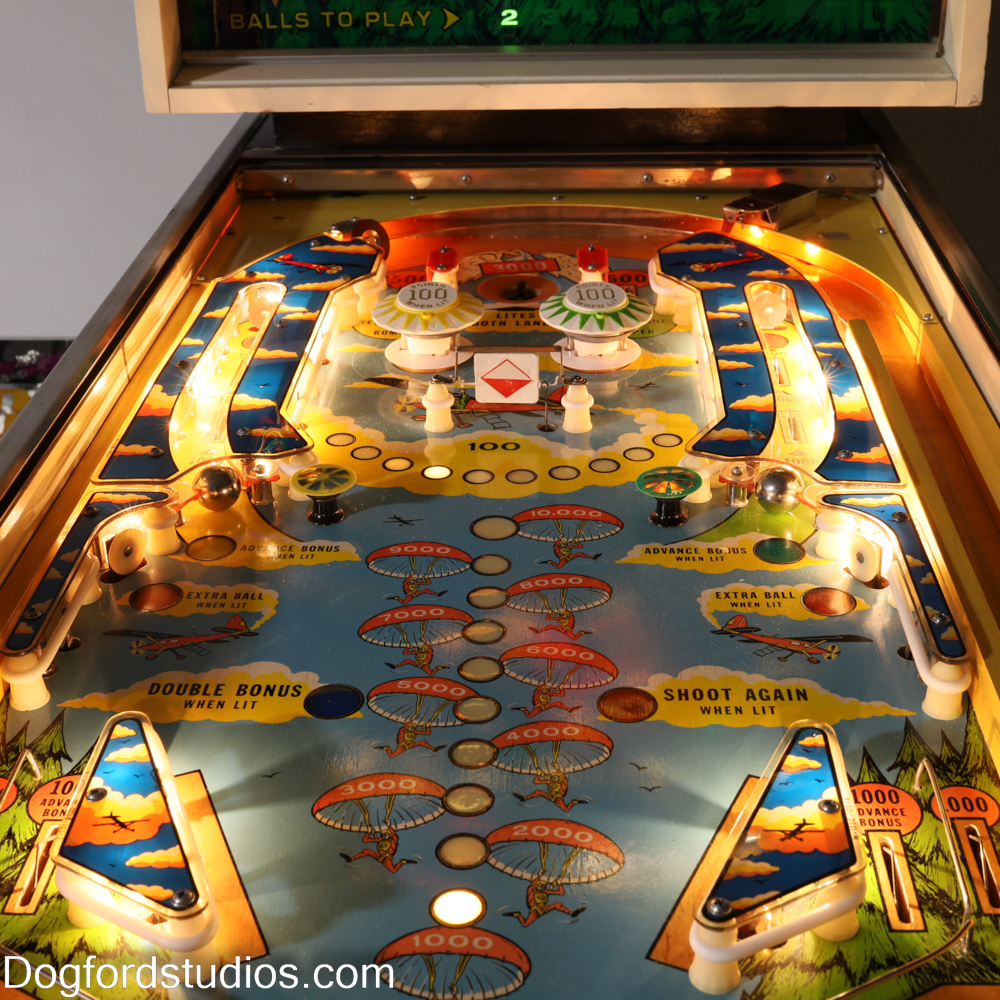When trying to track down a problem with a vintage pinball machine, observation is your most important tool. Visually inspecting the machine for a broken wire or some stuck switch on the playfield. Look for anything that might have fallen into the relays.
Where to Start
- What happened before you had an issue?
- Did you turn off the machine mid-game?
- Try shutting off the machine and then restarting it.
- Can you hear the buzzing of a stuck-on coil? Is the buzzing on the relay board at the bottom of the cabinet or coming from the backbox?
- Remove the glass and check every switch. Look for a switch that is stuck on.
- Are the score reels resetting to zero? The reset procedure can not continue until the score reels reset.
- Are the slingshots firing repeatedly? The rubbers might be getting old and pushing the switches closed. Adjust with a switch adjustment tool.
- Have you not played the game in a long time? EM pinball machines like to be used as the action keeps the relay contacts clean.
- Has anything fallen onto the relays? Is anything pushing against any switches such as paperwork stored inside the cabinet?
- Follow the start-up sequence to narrow down the problem. Pull out the schematics and use the wire colors to trace back to a switch on the score motor or relay. Clean switch contacts with a q-tip and alcohol. Check the action of the relay and switches. Carefully adjust with a switch adjustment tool if needed.
The Start-Up Sequence
The following information is taken from the January 1975 Gottlieb Out of Sight manual. This may be helpful when debugging a startup problem with this or other Gottlieb 2-player games from the same period.
1. Inserting a coin or pushing the replay (start) button actuates ‘S’ relay (Start relay).
2. This relay will lock-in through its own switch and a motor 2B switch.
3. ‘S’ relay starts the motor running.
4. ‘SB2’ and the total play meter are actuated by a switch on motor 2C through a switch that has been closed on ‘S’ relay.
5. When ‘SB2’ relay is tripped, the score units and player unit reset sequence starts. The 1st player score units reset to zero through the P3 switch stack on the player unit by motor switch 1A. When these units reach zero the player unit steps once, the 2nd player score units reset to zero through the P4 switch stack on the player unit by motor switch 1A. When these units reach zero the player unit steps until P5A opens. The score units and player unit are now reset.
6. The control bank is reset by a switch on motor 1B through a switch on ‘U’ relay.
7. Inserting additional coins or pushing the replay button will actuate the 2nd player relay (PB) through motor 2C switch.
8. Place the ball in the out hole. The ball return switch closes and completes the circuit to ‘O’ relay through the zero position switch on the bonus unit and ‘QB’. ‘O’ relay locks-in through its own switch and a switch on motor 2B. When ‘O’ relay is energized, motor 4C actuates the ball return coil (which kicks the ball onto the runway) through a switch on ‘O’ and normally closed switches on ‘P’ and ‘XB’ relays. The ball is now on the runway and is ready to be put into play.
9. The remaining balls that enter the outhole are kicked across the trough switch which pulls in ‘P’ relay. ‘P’ relay pulls in ‘O’ relay which runs the motor. Switches on ‘XB’, ‘ZB’, motor 2C, ‘P’, and motor 1A advances the ‘Player’ unit the required number of steps determined by the ‘Player’ unit switches and the player relay. (PB)
More pinball repair resources in the New Hampshire/Maine/Massachusetts area:
- Framingham, MA – Stu Bloomstien at https://www.vintagepinballrepair.com/
- Hollis Center, Maine – Maine Pinball Repair – http://mainepinballrepair.com/
- Pelham, NH – https://www.myarcaderepair.com/
Fix it yourself
- PinballHelp – https://pinballhelp.com/category/electro-mechanical/
- PinRepair – http://www.pinrepair.com/em/index1.htm
- Pinside Forums – http://www.pinside.com
- Goat Shed EM Pinball – https://www.youtube.com/channel/UCxFg0qzQVnQbydjJt0WlYRQ
- Joe’s Classics Pinball Repair – Gottlieb repair videos – https://www.youtube.com/@LyonsArcade/playlists?view=50&sort=dd&shelf_id=3
What if I can’t fix it myself and don’t want to pay for it to be fixed?
If you don’t have the time or will to learn how to fix your pinball machine or you don’t want to pay for it to be fixed, you have the option of selling it or trading it with a pinball enthusiast who can fix it.
SELL: A non-working pinball machine will sell for less than a working one but if you state in the description what the issue is and how it was working up to that point, a savvy pinball hobbyist will probably understand that it only needs a little bit of work to get it going again. Try listing on Facebook Marketplace, Craigslist and Pinside. Pinside is a pinball hobby website so it is very targeted at the pinball enthusiasts in your area. The downside of selling is now you won’t have a pinball machine.
TRADE: Another option is putting up your game for trade. There might be someone who will be willing to swap out your non-working game with a working game. You might end up with a less collectible game or have to add some cash to the deal but you’ll end up with a working game.
You could also try trading up your electro-mechanical pinball machine for a potentially more reliable Solid State pinball machine. Basically, offering your machine plus cash for a more expensive pinball machine.

[…] Troubleshooting a 1970s Gottlieb Two-Player Pinball Machine gottliebjumping jackpinballpinball machinepinball machine for sale By Edward Fielding […]